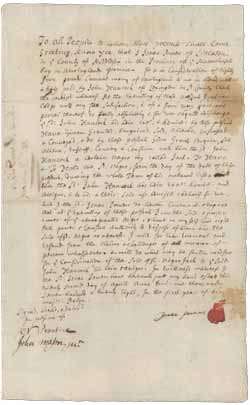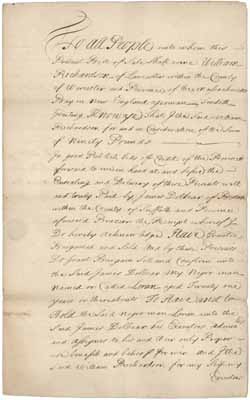The Domestic Sale of Enslaved People
~Isaac Powers, 22 April 1728
Many families of means in colonial Boston owned enslaved people, and even ordinary tradesmen kept enslaved people along with indentured servants to help with their businesses. Enslavement transactions were completed with regular bills of sale, and were witnessed, signed, and recorded like the sale of other property, such as real estate. The average price for an enslaved person in the seventeenth century was between £20 and £30 sterling; in the eighteenth century it was higher, and varied, but averaged about £40 to £50 sterling (Greene, 318). Typical bills of sale for enslaved people are Andrew Boyd to John Chandler for Dinah (an enslaved person) (1769), Malachy Salter, Jr. to Capt. James Dalton for an enslaved person (1749), General John Fellows to Theodore Sedgwick for Ton (an enslaved person) (1777), Isaac Powers to John Hancock for Jack (an enslaved person) (1728), Nathaniel Brown to Elizabeth Cabot for Phillis (an enslaved person) (1768), William Waitt to James Dalton for Peter (an enslaved person) (1747), and William Richardson to James Dolbeare for Loran (an enslaved person) (1732).
 Deed from Isaac Powers to John Hancock for Jack (an enslaved person), 22 April 1728
Deed from Isaac Powers to John Hancock for Jack (an enslaved person), 22 April 1728
 Deed signed by William Waitt to James Dalton acknowledging the sale of Peter (an enslaved person), 29 July 1747
Deed signed by William Waitt to James Dalton acknowledging the sale of Peter (an enslaved person), 29 July 1747
 Bill of sale from William Richardson to James Dolbeare for Loran (an enslaved person), 9 March 1732
Bill of sale from William Richardson to James Dolbeare for Loran (an enslaved person), 9 March 1732
In some cases, sales agreements of African Americans contained special clauses or variations. Patience Hatch sold her "half-ownership" of an enslaved boy named Salathiel to Silvanus Hatch in 1760. James Dalton paid Ezekiel Lewis Jr. $40 plus an enslaved man named Prince in 1750, for Lewis's slave named Pompey. Dr. Joseph Warren purchased an enslaved person from Joshua Green in 1770, paying £30 and promising £10 worth of "potters ware" within three months if their work proved satisfactory.
Disputes and problems occasionally arose regarding the sale and ownership of enslaved people. Anna Bill gave written testimony in 1761 concerning the sale of two slaves by Capt. John Sale to Nathaniel Brown. Capt. Sale was sued the following year for illegally selling free Black people as slaves to John Oliver (Desrochers, 636), so there may have been some question as to his ownership of these two. In 1740, Mary Mountire testified as to her sole ownership of two enslaved men, Kent and Sambo, so that they would not be sold as part of her deceased husband's estate. A buyer could "try out" an enslaved person with an eye to later purchase; Samuel Bowman wrote to Samuel P. Savage in 1752 to explain why he could not keep a man named Pompe, whose behavior made Bowman's wife uneasy.
Featured Items
- Bill of sale from Andrew Boyd to John Chandler for Dinah (an enslaved person), 20 February 1769
- Bill of sale from Malachy Salter, Jr. to James Dalton for an enslaved person, 14 November 1749
- Bill of sale from John Fellows to Theodore Sedgwick for Ton (an enslaved person), 1 July 1777
- Bill of sale from Isaac Powers to John Hancock for Jack (an enslaved person), 22 April 1728
- Bill of sale from Nathan Brown to Elizabeth Cabot for the sale of Phillis (an enslaved person), 26 August 1768
- Deed signed by William Waitt to James Dalton acknowledging the sale of Peter (an enslaved person), 29 July 1747
- Bill of sale from William Richardson to James Dolbeare for Loran (an enslaved person), 9 March 1732
- Bill of sale from Patience Hatch to Silvanus Hatch for Salathiel (an enslaved person), 8 February 1760
- Receipt from Ezekiel Lewis Jr. to James Dalton for exchange of Prince (an enslaved person) for Pompey (a slave), 25 April 1750
- Agreement of Joseph Warren with Joshua Green regarding payment for an enslaved person, 28 June 1770
- Testimony of Anna Bill (manuscript copy) about the sale of two enslaved people, October 1761
- Deposition of Mary Mountire about the ownership of Kent and Sambo (two enslaved people), 16 April 1740
- Letter from Samuel Bowman to [Samuel P. Savage?], 14 October 1752
Next essay: the Lives of Individual African Americans before 1783 >

